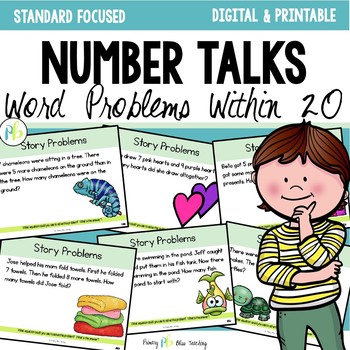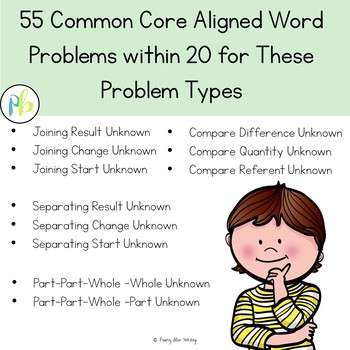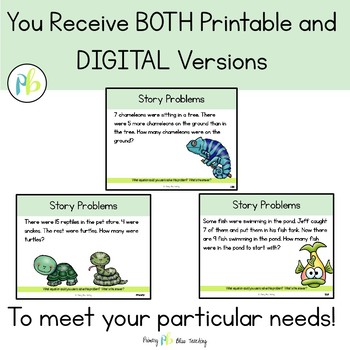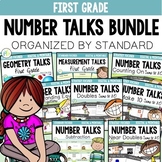Word Problem Number Talks for First Grade
- Zip
- Google Apps™

What educators are saying
Also included in
- Math Talks are hands-down the best math warm-up activities for developing number sense and computational fluency. And these Number Talks for first grade make implementing Number Talks easier than ever.This seriously NO PREP resource provides daily lessons that are thought-provoking and engaging forPrice $37.00Original Price $67.50Save $30.50
- This Word Problem BUNDLE for addition and subtraction within 20 is all you need to turn your first-grade students into math problem solver superstars. Included in this BUNDLE are:110 Word Problem-based Number Talks for all 4 types of word problems with unknowns in all positions (BOTH Digital and PriPrice $20.00Original Price $27.00Save $7.00
Description
These PAPERLESS NUMBER TALKS are perfect for reinforcing how to solve word problems with your first graders. Best of all, you literally just click, teach, and listen to your students' mathematical conversations flow.
This is an easy way to increase your students' abilities to effectively solve word problems. These NO PREP Number Talks are easy to use, standards-based, and guaranteed to get your student talking up a storm about math!
Our word problem math talks are focused on using addition and subtraction to solve word problems within 20 for all 4 problem types (joining, separating, part-part-whole, and comparing).
THESE UNITS CAN BE USED ON INTERACTIVE WHITEBOARDS, ARE COMPATIBLE WITH GOOGLE SLIDES, OR CAN BE PRINTED OUT. ALL THREE VERSIONS ARE INCLUDED.
They are aligned with the first grade Common Core Standard 1.OA.A.1.0.
There are 55-word problem number talks in all. Five for each of the following categories:
- Joining – Result Unknown
- Joining – Change Unknown
- Joining – Start Unknown
- Separating – Result Unknown
- Separating – Change Unknown
- Separating – Start Unknown
- Part-Part-Whole – Whole Unknown
- Part-Part-Whole – Part Unknown
- Compare – Difference Unknown
- Compare – Quantity Unknown
- Compare – Referent Unknown
BENEFITS:
Number Talks will get your students engaged in mathematical conversations that will increase their ability to reason mathematically as well as develop their computational fluency skills and their ability to think flexibly about numbers.
These word problem-based number talks will give your students the opportunity to truly process word problems and problem-solve ways to solve the problems.
OUR STORY:
A few years ago, we were asked to implement number talks in our daily math instruction. After engaging our students in a few of these activities, we were hooked. Our challenge then became to create a variety of problem types in order to keep students engaged and excited about number talks. And that is when this number talk program was born.
Word problems prove to be challenging for first graders. For this reason, we created the word problem number talks to give students the opportunity to engage in word problems in a way that is stress-free and engaging.
THIS RESOURCE IS HELPFUL FOR:
- Busy First-Grade Teachers
- Substitute Teachers
- Special Education Teachers
- Whole Group Math Instruction
- Small-Group Math Instruction
- Math Intervention
- As a Supplement to Core Instruction
FAQ:
How long do number talks take?
It is best if Number Talks are done daily for between 5 and 15 minutes.
Can these number talks be displayed on an interactive whiteboard?
Yes! You will receive BOTH a DIGITAL product and a PRINTABLE product to meet your particular needs.
============================================================================
Click HERE to follow us and receive notifications for sales, new resources, and FREEBIES!
PLEASE LEAVE FEEDBACK on this product to earn TPT credits that can be used on future purchases!
Happy Teaching!
Becky & Cindy
Team Primary Bliss Teaching







